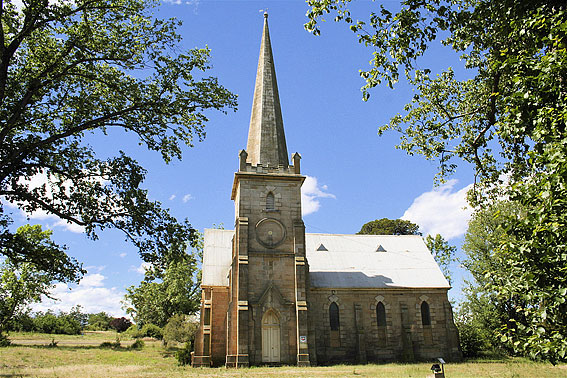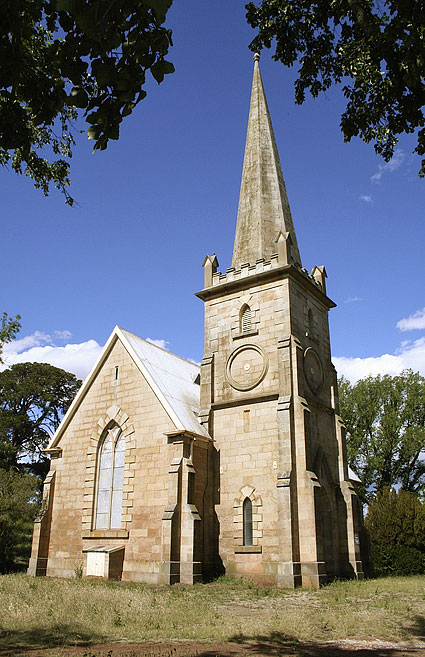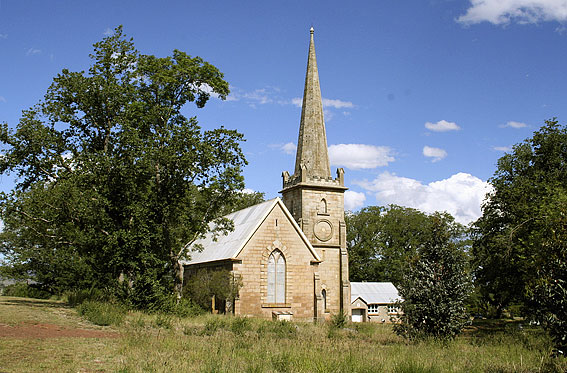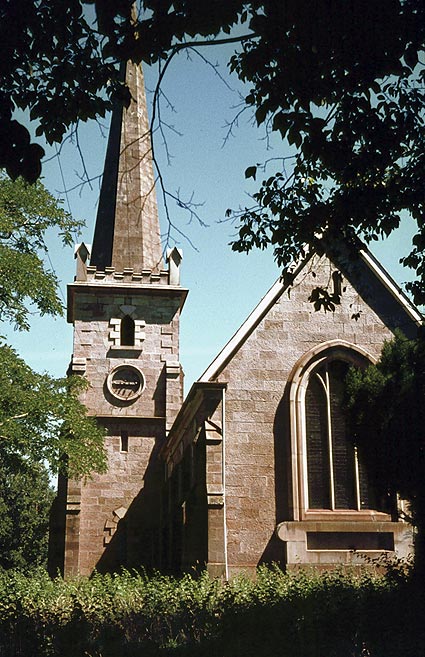Campbell Town
B. 1847 J.C. Bishop, London for 'Runnymede', New Town,
the residence of Bishop F.R. Nixon. Inst. present loc. 1863.
1 manual, 8 speaking stop, pedal pulldowns, mechanical action.


An early Victorian Gothic Revival sandstone church (c. 1857) with iron gabled roof and square tower with castellated parapet, clock mouldings and needle spire. It contains an organ and desk that belonged to Bishop Nixon, first Anglican Bishop of Tasmania. It is considered one of the best churches built in Australia of the period. The church is a landmark in the town. [1]
St Andrew's Church was built in 1847 as a Presbyterian Church and is of note for its tower and needle spire, and interior with unaltered fittings [1].J.C. Bishop, of London, built this instrument in 1847 to the order of Bishop F.R. Nixon. Graeme Rushworth's research has revealed [2]:
'From subsequent press reports it seems that the J.C. Bishop organ was not intended for Nixon's own use, but for Christ's College at Bishopsbourne, Norfolk Plains, near Launceston; on 11 March 1847 it was reported that "His Lordship has sent an organ to the College - one of Bishop's best" [3]. So far it has not proved possible to establish when or at which port the organ arrived, or if it went to Christ's College before it was installed at Nixon's residence 'Runnymede', at New Town, Hobart' (now a National Trust property). However, the date of the press report precedes the date of the order in the firm's records, so it is possible that this may have been another Bishop organ (possibly one of the instruments now at Carrick or Cressy).
In 1863 the organ was moved to its present location [4] where it has been preserved without essential alteration, although it appears from some stray supporting brackets that the Gothic case may have once been surmounted by a cornice.
The J.C. Bishop estimate book has the following entry relating to this instrument.
April 30, 1847
Bishop of Tasmania
Estimate by J.C. Bishop to build an organ of the following description:
compass from GG to F in alt with GG#, and containing the following stops.
1. Open dip. bass to CC in metal, lower notes wd.
2. Open diap. treble
3. Clarabella treble
4. Stopt dia bass wood
5. Stopt diap treble metal
6. Dulciana treble
7. Dulciana bass
8. Flute bass to Tenor C open pipes and stopt to the bottom
9. Principal
10. Fifteenth
11. Hautboy to Fid. G
12. Flute treble
"bellows to feed double with compensation fold"
An octave and half of German pedals and five composition pedals.
Spotted metal pipework
General venetian swell
220 guineas erected at Lisson Grove [5]
[1] The Heritage of Australia, p.7/96.[2] Graeme Rushworth 'Notes on some Early Tasmanian Organs and also on the commencement of the Hobart Town Choral Society', OHTA News, vol. 23, no. 2 (April 1999), p.37.
[3] Hobart Town Courier (11 March 1848), p.2.
[4] N. Nixon, The Pioneer Bishop in Van Diemen's Land 1843-1863. Hobart, 1953, pp.12-13. 54.
[5] Specification noted from records of Bishop & Son, London, 1975 John Maidment.






Three church photos: Trevor Bunning (Dec 2008)

Photo: Trevor Bunning (Feb. 1970)